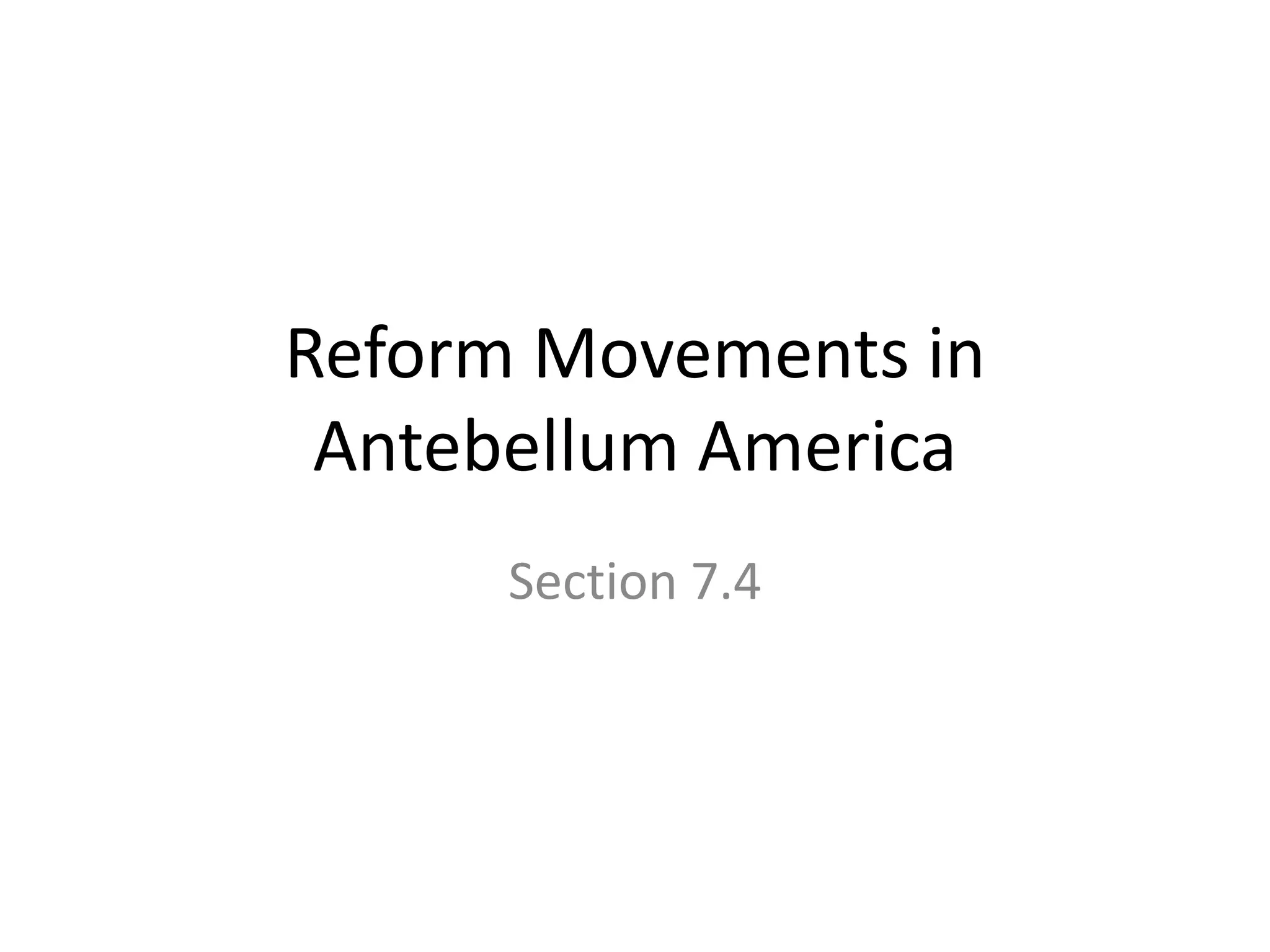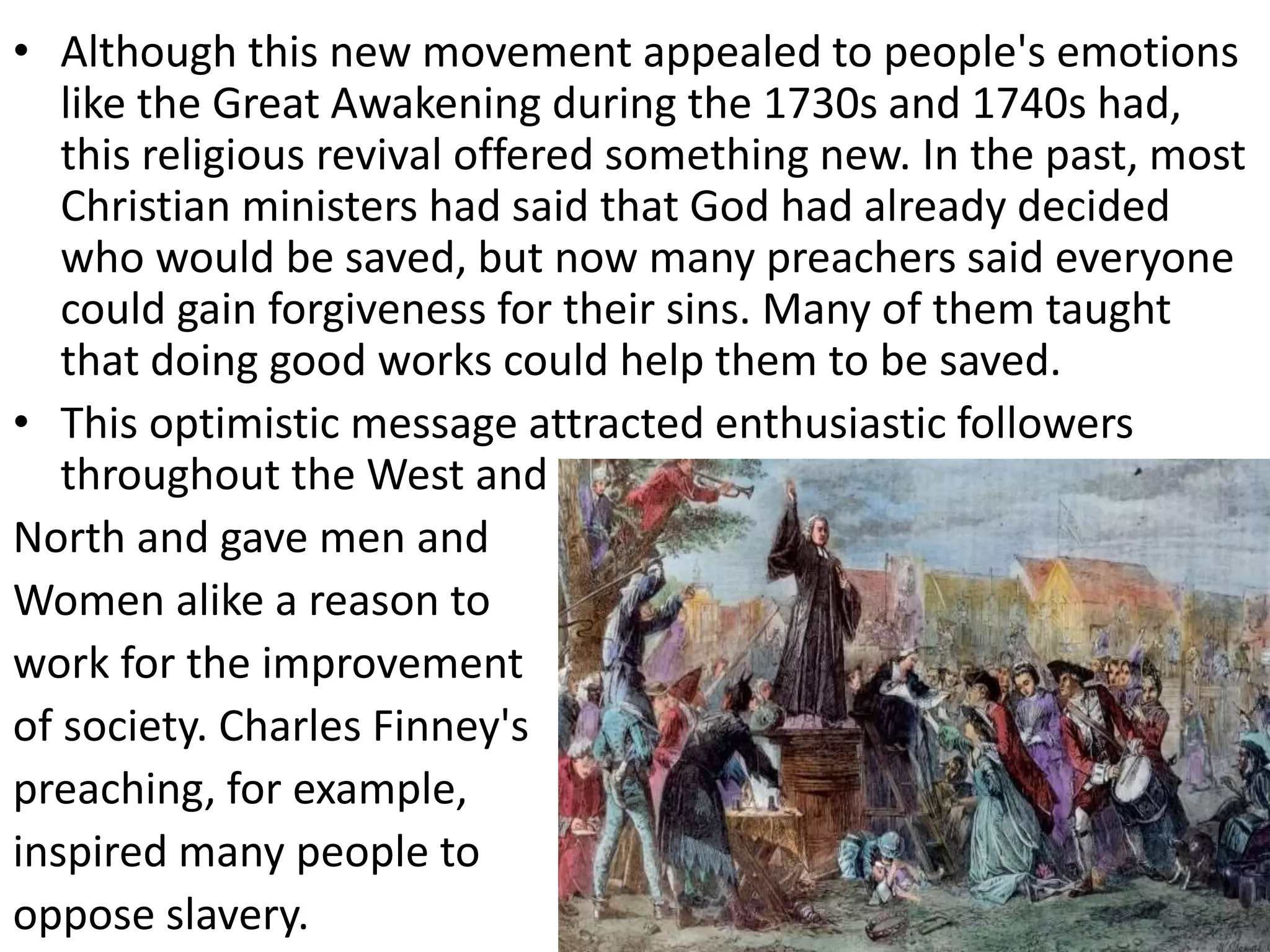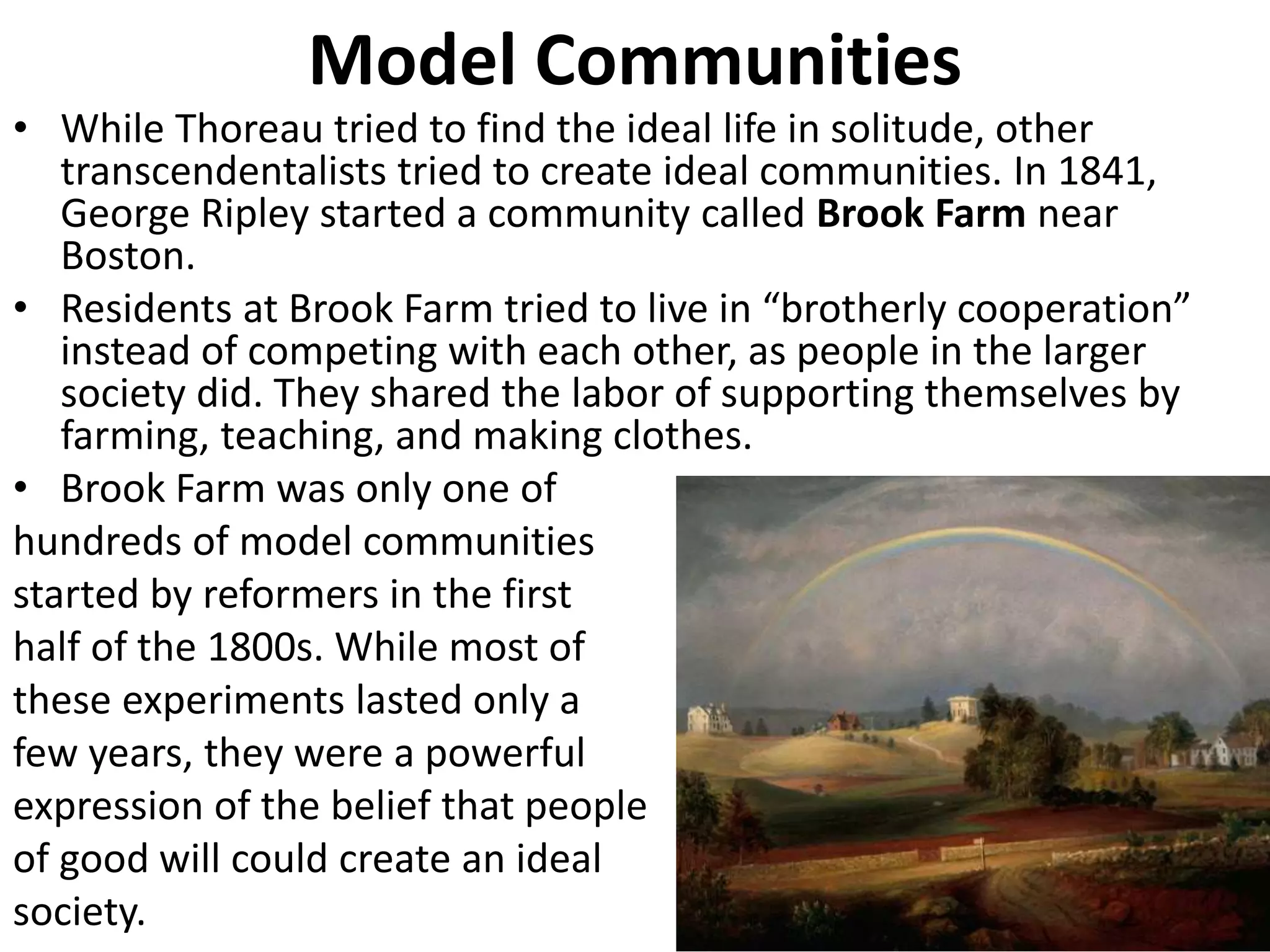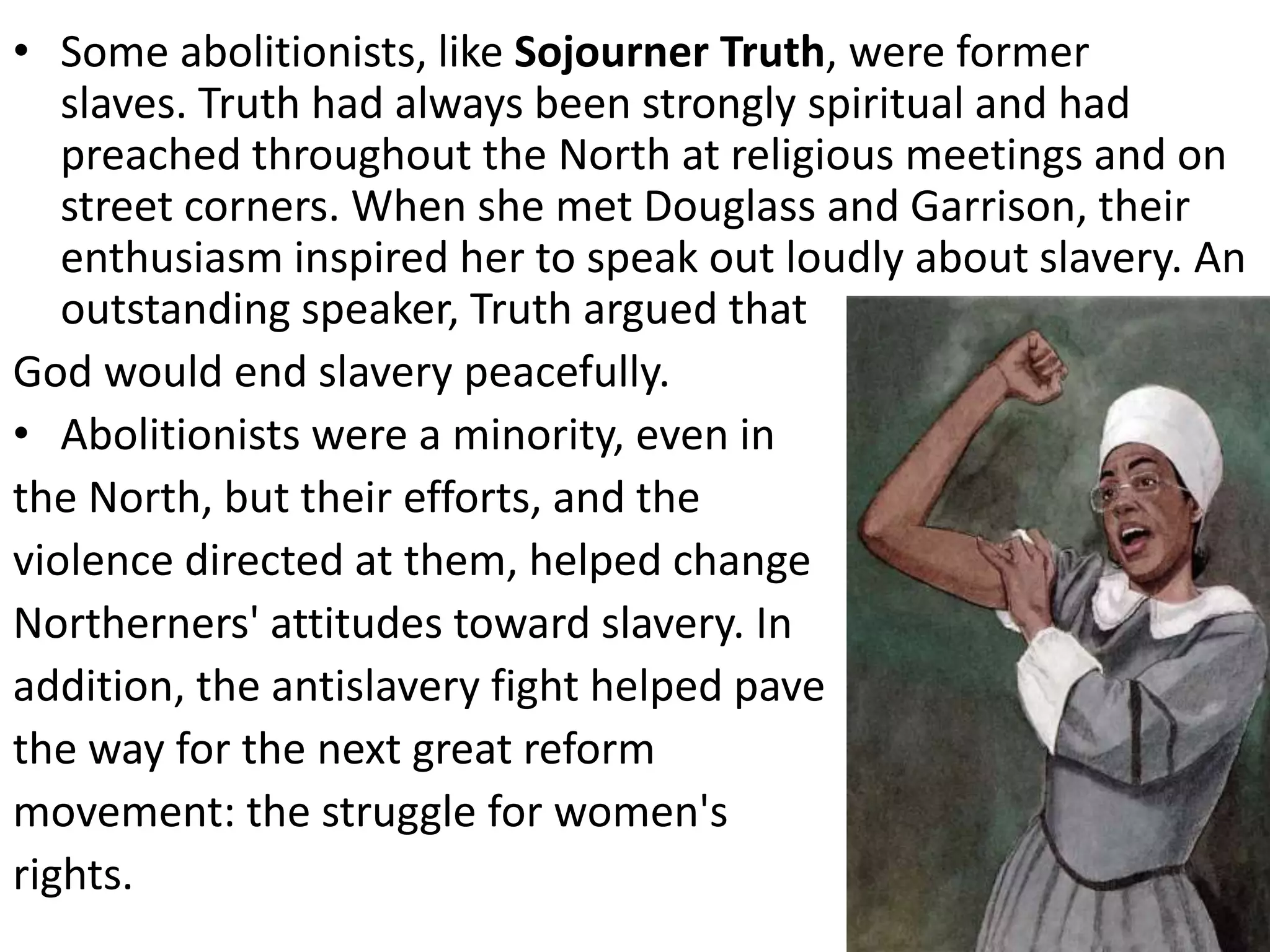The document details various reform movements in antebellum America, particularly highlighting the Second Great Awakening, education reforms led by Horace Mann, and the abolitionist movement. Key figures like Charles G. Finney and Dorothea Dix pushed for societal improvements including humane treatment for the mentally ill and greater educational access. Additionally, it discusses the emergence of women's rights through leaders like Elizabeth Cady Stanton and Lucretia Mott amid the broader context of social reform.

![The Spirit of Reform
• New religious movements played a key role in inspiring thousands of
Americans to try to reform [to make change in order to bring about
improvement, end abuses, or correct injustices] society.
The Second Great Awakening
• A revival of religious feeling, which church leaders called the Second Great
Awakening [Second Great Awakening: a revival of religious feeling and
belief from the 1800s to the 1840s] , swept across the nation from the
1800s to the 1840s.
Day after day, people gathered in churches
and big white tents to hear messages of
hope. Preachers like Charles G. Finney, a
leader of the movement, urged Christians
to let themselves be “filled with the Spirit
of God.” Their listeners prayed, shouted,
sang hymns, and sometimes even cried for
hours or fell down in frenzies.](https://image.slidesharecdn.com/7-210422001816/75/Reform-Movements-in-Antebellum-America-2-2048.jpg)

![Optimistic Ideas
• Other optimistic ideas also inspired Americans during this time. In New
England, Ralph Waldo Emerson, a former minister, was the central figure in
a movement called transcendentalism [a philosophy emphasizing that
people should transcend, or go beyond, logical thinking to reach true
understanding, with the help of emotions and intuition] . Emerson believed
that every human being has unlimited potential, but in order to
realize their godlike nature, people
have to transcend, or go beyond,
purely logical thinking. They can find
the answers to life's mysteries only
by learning to trust their emotions
and intuition.
• Transcendentalists added to the
spirit of reform by urging people to
question society's rules and
institutions. Do not conform to others'
expectations, they said. If you want to
find God—and your own true self—look to nature and the “God within.”](https://image.slidesharecdn.com/7-210422001816/75/Reform-Movements-in-Antebellum-America-4-2048.jpg)
![• Emerson's friend Henry David Thoreau captured this new individualism [to
act based on one’s own beliefs] in a famous essay. “If a man does not keep
pace with his companions,” wrote Thoreau, “perhaps it is because he hears
a different drummer. Let him step to the music which he hears.”
• In 1845, Thoreau demonstrated that he practiced what he preached when
he went into the woods near Concord, Massachusetts to live alone and as
close to nature as possible.
• Thoreau spent more than two years in solitude, recording his thoughts in a
6,000-page journal. In 1846, he was jailed overnight for refusing to pay
taxes because of his opposition to the government's involvement in the
Mexican-American War.](https://image.slidesharecdn.com/7-210422001816/75/Reform-Movements-in-Antebellum-America-5-2048.jpg)

![Prison Reform
• One day in 1841, a Boston woman named Dorothea Dix agreed to
teach Sunday school at a jail. What she witnessed that day
changed her life forever.
• Dix was horrified to see that many prisoners were bound in chains
and locked in cages, while children accused of minor thefts were
jailed with adult criminals. Were conditions this bad everywhere?
• Dix devoted [to give time, money, or effort to
help a person or cause] herself to finding out the
answer to her question and visited hundreds of
jails and prisons throughout Massachusetts. She
also visited debtors' prisons, or jails for people
who owed money, and found that most of the
thousands of Americans in debtors' prisons owed
less than 20 dollars. While they were locked up,
they could not earn money to repay their debts
and thus remained imprisoned for years.](https://image.slidesharecdn.com/7-210422001816/75/Reform-Movements-in-Antebellum-America-7-2048.jpg)






![The Movement to End Slavery
• In 1835, a poster showing two drawings appeared on walls
throughout Washington, D.C. One drawing, labeled “The Land
of the Free,” showed the founding fathers reading the
Declaration of Independence. The other, labeled “The Home
of the Oppressed,” showed slaves trudging past the U.S.
Capitol building, the home of Congress.
• The poster posed a challenging
question: How could America, the
“land of the free,” still allow slavery?
By the 1830s, growing numbers of
people were asking this question.
These people were called abolitionists
[a person who supported abolition, or
the ending of slavery] .](https://image.slidesharecdn.com/7-210422001816/75/Reform-Movements-in-Antebellum-America-14-2048.jpg)


![Frederick Douglass Speaks Out
• One day, Garrison heard an escaped slave, Frederick Douglass, speaking at a
meeting of abolitionists. Over six feet tall, Douglass spoke with a voice like
thunder. When he described the cruel treatment of enslaved children,
people cried. When he made fun of ministers who told slaves to love
slavery, people laughed.
When he finished, Garrison jumped up and
cried, “Shall such a man be held a slave in a
Christian land?” The crowd called out, “No!
No! No!”
• Douglass quickly became a leader in the
abolitionist movement, and his autobiography,
published in 1845, became an instant best
seller. A brilliant and independent thinker,
Douglass eventually started his own newspaper,
North Star, whose motto read, “Right is of no
Sex—Truth is of no Color—God is the Father of
us all, and we are all Brethren [brothers].”](https://image.slidesharecdn.com/7-210422001816/75/Reform-Movements-in-Antebellum-America-17-2048.jpg)






![The Seneca Falls Convention
• Eight years passed before Stanton and Mott met again. Over afternoon tea at the
home of Mott's sister, they decided to send a notice to the local newspaper
announcing a women's convention in Seneca Falls, New York. The organized
movement for women's rights was about to begin.
• On July 19, 1848, nearly 300 people, including 40 men, arrived for the Seneca Falls
Convention [the gathering of supporters of women’s rights in July 1848 that
launched the movement for women’s right to vote] . While many were
abolitionists, Quakers, or other reformers, some
were local housewives, farmers, and factory
workers.
• The convention organizers modeled their
proposal for women's rights, the Declaration of
Sentiments [a formal statement of injustices
suffered by women, written by the organizers of
the Seneca Falls Convention. Sentiments means
“beliefs” or “convictions.”] , on the Declaration
of Independence. “We hold these truths to be self
-evident,” the document began, “that all men and
women are created equal.”](https://image.slidesharecdn.com/7-210422001816/75/Reform-Movements-in-Antebellum-America-24-2048.jpg)
![• Just as the Declaration of Independence listed King
George's acts of tyranny over the colonists, the new
declaration listed acts of tyranny by men over
women. Man did not let woman vote, give her the
right to own property, nor allow her to practice
professions like medicine and law.
• Stanton's presentation of the declaration at the
convention was her first speech. A few other
women also spoke, including a 19-year-old factory
worker named Charlotte Woodward. “Every fibre of
my being,” she said, “rebelled [against] all the hours
that I sat and sewed gloves for a miserable pittance
[small amount of money] which, as it was earned,
could never be mine.”](https://image.slidesharecdn.com/7-210422001816/75/Reform-Movements-in-Antebellum-America-25-2048.jpg)



